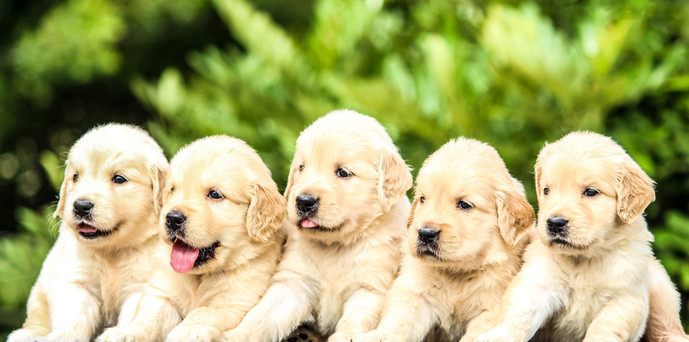Puppies 101
- Kimberly

- Oct 2, 2020
- 5 min read
Updated: Nov 11, 2020
I can’t think of too many things that are better for the soul (or more fun) than a delightfully fuzzy puppy playing at your feet. As we navigate these uncertain times and with so many families at home, people are fostering and adopting canine companions to ride out the Corona wave with. For those of you entertaining puppyhood (and for those of you in the throes of it); here are some tips to help you navigate everything from “puppy proofing” your house to crate training.
Shopping for the Essentials You’re going to want to make sure that you have all the necessities before bringing your new friend home. The following things should be on your shopping list and all of this can be purchased via online retailer Chewy, Inc.
Collar and ID Tag NOTE: depending on your pup’s breed, you might need a harness too.
Crate: this is a great mechanism to keep your puppy out of trouble when you’re not home and also assist in housebreaking. NOTE: make sure you get the right size; if it’s too large your pup might use one end as a potty.
Puppy Food & Food/Water Dishes NOTE: Top 10 Best Puppy Foods according to DogFoodAdvisor. Don’t forget to stock up on treats too … they make for tasty rewards!
Exercise Pen or Baby Gates
Chew Toys: I cannot stress this one enough! Puppies love to chew… anything! NOTE: prevent choking hazards by avoiding toys that are too small.
Grooming Tools
Keeping Your Space Safe
Puppies are similar to toddlers in that they are unbelievably inquisitive and will want to check out and investigate everything. Much like toddlers, they don’t know what is off limits or unsafe. Remember what I said about chewing? If a puppy can put something in his mouth; he will.
As strange as this sounds, walk around your home and try to look at it from your puppy’s point of view. Keep potentially toxic items like cleaning supplies, medicine, etc. stored up high or in a locked cabinet. Keep your shoes in a closet (unless you want Fido treating your Louboutin as his new favorite chew toy!)

Garbage cans should have lids, electrical cords should be out of reach, fragile knickknacks should be put on higher shelves… you get the picture. This is where the baby gates can help tremendously! If you can’t (or don’t want to) puppy proof your entire home; these can be great to keep your four legged friend in or out of specific areas. When looking for hazards, don’t forget the backyard. Be on the lookout for toxic plants, holes in your gate or anything else that could cause trouble. Paperwork While we wish it could all be fun and games, there are some administrative tasks that you will need to take care of pretty early on. Once you’ve decided on a name get an ID tag printed with your pup’s name and your contact information. You should get your puppy to your veterinarian within 48 hours of bringing him home. Depending on your pup’s age, this visit might only be for a physical exam and weigh in or he might get his first round of vaccines. It’s also a good idea to know the location of the nearest 24 hour emergency clinic. You’re also going to want to find other professionals such as a pet sitter, groomer, etc. I always find it’s useful to ask for recommendations and make sure to get references.

Teaching & Training There’s no reason not to start teaching your pup good behavior from day one! Let your new friend know the house rules right away and make sure your family is all on the same page so that you can stay consistent with the “do’s” and “don’ts”. The biggest hurdle is probably potty training and the best way to tackle this is to establish a timeline and stick to it. You’re also going to want to let your pup know where you expect him to do his business (crates and puppy pads can be very useful here!) Start each day off with the same routine: wake up, get your puppy out of the crate and outside to go potty. It’s not bad idea to keep the crate in (or near) your bedroom so that you can hear any whimpering that might indicate he needs to go. Stick to routine as much as possible; always go out the same door and to the same area for your pup to go to the bathroom. Some people find it helpful to put them on a leash even if going into a fenced in yard so that they can react immediately and reward accordingly.

Try to keep meals scheduled at the same time each day. This will help regulate their potty time. After a meal take your puppy outside; it is suggested not to wait more than 30 minutes. The younger the pup, the sooner they will need to be taken out. Water intake should be treated almost like a meal too. They should be taken out soon afterwards and not given too much water right before bedtime. Remember, indoor accidents will happen and when they do don’t punish your pup. If you catch them in the act, get their attention and say “no” or make some other noise to make them stop. Pick them up gently, take them outside and make sure to praise them when they finish.
It’s best to leave your puppy in his crate when you are leaving home for many hours. Unsure about how many hours your pup can hold it? There is something called the “month-plus-one” rule. Take your puppy’s age (in months) and add one; this will give you the maximum number of hours your puppy should be able to go between potty breaks. The last thing you should do before going to bed is take your pup out for a final bathroom break of the day. In addition to monitoring food and water intake before bedtime, puppies are usually able to hold their bladder for a longer period of time when they are sleeping and not active.
Positive reinforcement-based training is a great way to encourage good behavior even in very young dogs. If you find that you’re struggling or just need a little help; enlist your puppy in puppy “kindergarten” (essentially a training class) to help with discipline and socializing.

These basics should get you and your pup off and running to a wonderful life full of fun, love, tricks and slobbery kisses. Enjoy!
To learn more about how we can help you with your puppy, check out our Services page or Contact us directly.
About the Author
The daughter of an award-winning travel writer, Kimberly has followed in her mother’s footsteps and has had articles been published in numerous publications. Kimberly got her first puppy from Santa Claus when she was four years old and has never known a life that didn’t include four legged family members. An animal advocate, she has rescued pets, volunteered at shelters and has even been known to nurse an injured sparrow back to health. When she’s not busy running a successful petcare business and providing care to her four legged customers, you can rest assured she is pampering her 19 year old kitty, Scout.













Comments